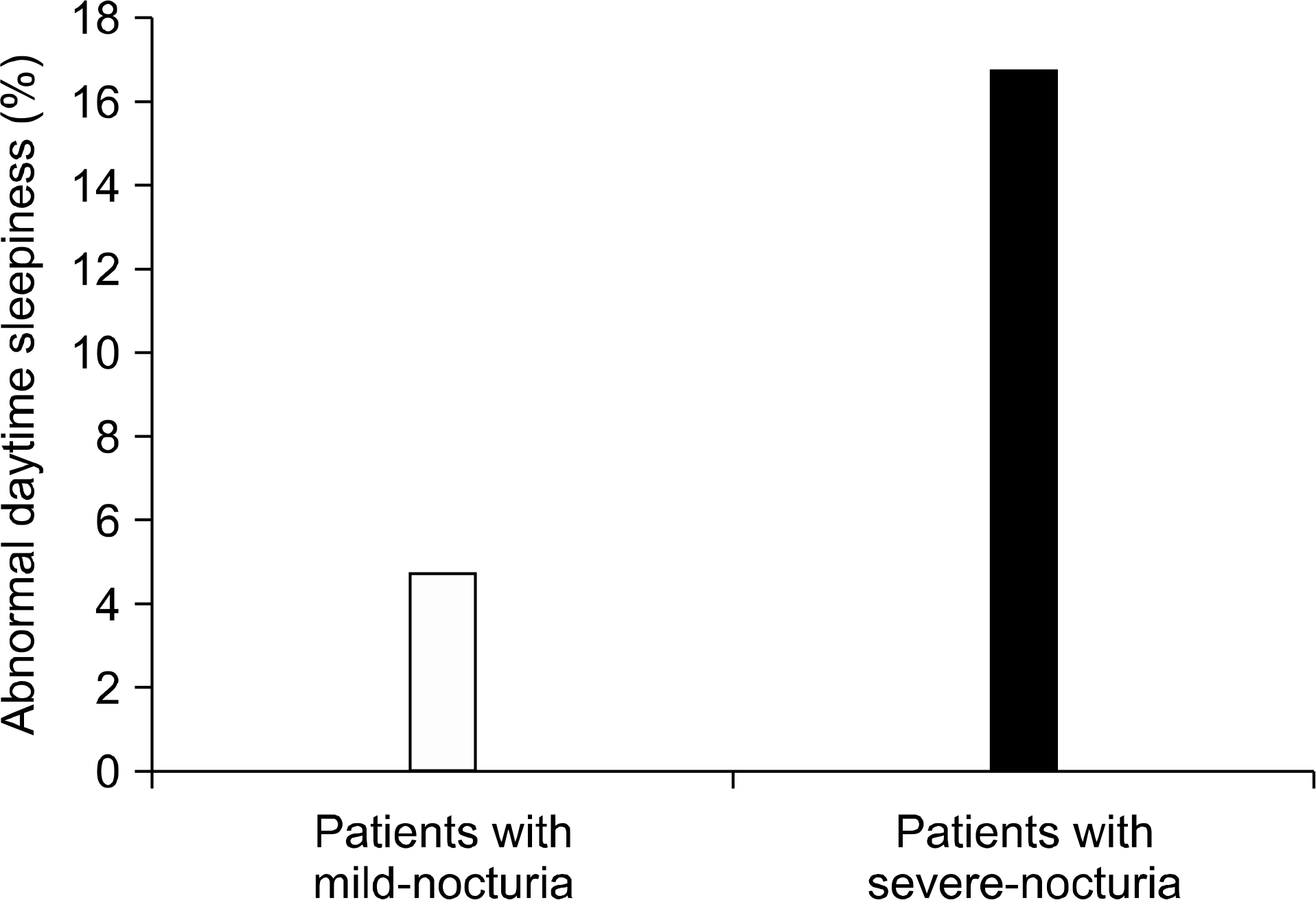Abstract
Purpose
Nocturia is one of the most bothersome lower urinary tract symptoms (LUTS). The aim of the prese study is to determine whether severe-nocturia have impact on the abnormal daytime sleepiness in men wit LUTS/benign prostate hyperplasia (BPH).
Materials and Methods
Severe-nocturia was classified as twice or more per night. A total of 85 men met th criteria and constituted the study cohort. The patients had a detailed clinical evaluation, including a complete histor physical examination, urine analysis, urine culture, a digital rectal examination, serum prostate-specific antigen (PSA level, prostate volume by transrectal ultrasonography, uroflowmetry and postvoid residual urine volume. LUTS an symptom-specific quality of life (QoL) were assessed using the IPSS. Patients were asked to complete an Epwort Sleepiness Scale questionnaire for daytime sleepiness.
Results
43 patients had less than one, 42 patients had more than two episodes of nocturia. There was no significa difference of age, total prostate volume, PSA levels between patients with mild-nocturia and severe-nocturia. Ther was no significant difference of maximum flow rate (Qmax), voided volume and postvoid residual urine volume (PV between patients with mild-nocturia and severe-nocturia. There was significant decrease of total International Prostat Symptom Score (IPSS) scores and QoL index in patients with severe-nocturia compared in patients with mild-nocturi The number of patients with abnormal daytime sleepiness in mild-nocturia and severe-nocturia were 4.7% (2/43 16.7% (7/42), respectively (p<0.05). Regression coefficiency between percent of nocturia and total score of daytim sleepiness was significant (p<0.05) and regression coefficient (R) was 0.29.
Go to : 
REFERENCES
1). Yoshimura K, Ohara H, Ichioka K, Terada N, Matsui Y, Terai A, et al. Nocturia and benign prostatic hyperplasia. Urology. 2003; 61:786–90.

2). Asplund R, Aberg H. Health of the elderly with regard to sleep and nocturnal micturition. Scand J Prim Health Care. 1992; 10:98–104.

3). Shim JB, Lee SH, Kim H. A study of minimal change in nocturia affecting quality of life. Korean J Urol. 2009; 50:241–5.

4). Johns MW. A new method for measuring daytime sleepiness: the Epworth sleepiness scale. Sleep. 1991; 14:540–5.

5). Johns MW. Sensitivity and specificity of the multiple sleep latency test (MSLT), the maintenance of wakefulness test and the epworth sleepiness scale: failure of the MSLT as a gold standard. J Sleep Res. 2000; 9:5–11.

6). Johns MW. Sleep propensity varies with behaviour and the situation in which it is measured: the concept of somnificity. J Sleep Res. 2002; 11:61–7.

8). Chen NH, Johns MW, Li HY, Chu CC, Liang SC, Shu YH, et al. Validation of a Chinese version of the Epworth sleepiness scale. Qual Life Res. 2002; 11:817–21.
9). Gander PH, Marshall NS, Harris R, Reid P. The Epworth Sleepiness Scale: influence of age, ethnicity, and socioeconomic deprivation. Epworth Sleepiness scores of adults in New Zealand. Sleep. 2005; 28:249–53.

10). Chervin RD, Aldrich MS, Pickett R, Guilleminault C. Comparison of the results of the Epworth Sleepiness Scale and the Multiple Sleep Latency Test. J Psychosom Res. 1997; 42:145–55.

11). Olson LG, Cole MF, Ambrogetti A. Correlations among Epworth Sleepiness Scale scores, multiple sleep latency tests and psychological symptoms. J Sleep Res. 1998; 7:248–53.

12). Mitler MM, Doghramji K, Shapiro C. The maintenance of wakefulness test: normative data by age. J Psychosom Res. 2000; 49:363–5.
13). Gottlieb DJ, Whitney CW, Bonekat WH, Iber C, James GD, Lebowitz M, et al. Relation of sleepiness to respiratory disturbance index: the Sleep Heart Health Study. Am J Respir Crit Care Med. 1999; 159:502–7.
14). Kingshott RN, Engleman HM, Deary IJ, Douglas NJ. Does arousal frequency predict daytime function? Eur Respir J. 1998; 12:1264–70.

15). Chervin RD. The multiple sleep latency test and Epworth sleepiness scale in the assessment of daytime sleepiness. J Sleep Res. 2000; 9:399–401.

Go to : 
 | Fig. 1.Daytime sleepiness. The number of patients with abnormal daytime sleepiness in with mild nocturia and with severe nocturia were 4.7% and 19.0%, respectively (Fisher's exact test, p<0.05). |
Table 1.
Profines in patients with mild nocturia or severe nocturia




 PDF
PDF ePub
ePub Citation
Citation Print
Print


 XML Download
XML Download